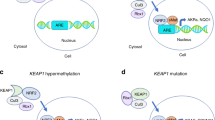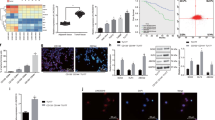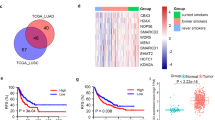Abstract
Long noncoding RNAs (lncRNAs) are emerging as key factors in various fundamental cellular biological processes, and many of them are likely to have functional roles in tumorigenesis. Maternally expressed gene 3 (MEG3) is an imprinted gene located at 14q32 that encodes a lncRNA, and the decreased MEG3 expression has been reported in multiple cancer tissues. However, nothing is known about the alteration and role of MEG3 in environmental carcinogen-induced lung tumorigenesis. Our present study, for the first time to the best of our knowledge, discovered that environmental carcinogen nickel exposure led to MEG3 downregulation, consequently initiating c-Jun-mediated PHLPP1 transcriptional inhibition and hypoxia-inducible factor-1α (HIF-1α) protein translation upregulation, in turn resulting in malignant transformation of human bronchial epithelial cells. Mechanistically, MEG3 downregulation was attributed to nickel-induced promoter hypermethylation via elevating DNMT3b expression, whereas PHLPP1 transcriptional inhibition was due to the decreasing interaction of MEG3 with its inhibitory transcription factor c-Jun. Moreover, HIF-1α protein translation was upregulated via activating the Akt/p70S6K/S6 axis resultant from PHLPP1 inhibition in nickel responses. Collectively, we uncover that nickel exposure results in DNMT3b induction and MEG3 promoter hypermethylation and expression inhibition, further reduces its binding to c-Jun and in turn increasing c-Jun inhibition of PHLPP1 transcription, leading to the Akt/p70S6K/S6 axis activation, and HIF-1α protein translation, as well as malignant transformation of human bronchial epithelial cells. Our studies provide a significant insight into understanding the alteration and role of MEG3 in nickel-induced lung tumorigenesis.
This is a preview of subscription content, access via your institution
Access options
Subscribe to this journal
Receive 50 print issues and online access
$259.00 per year
only $5.18 per issue
Buy this article
- Purchase on Springer Link
- Instant access to full article PDF
Prices may be subject to local taxes which are calculated during checkout






Similar content being viewed by others
References
Siegel RL, Miller KD, Jemal A . Cancer statistics, 2016. Ca-Cancer J Clin 2016; 66: 7–30.
Field RW, Withers BL . Occupational and environmental causes of lung cancer. Clin Chest Med 2012; 33: 681–703.
Kasprzak KS, Sunderman Jr FW, Salnikow K . Nickel carcinogenesis. Mutat Res 2003; 533: 67–97.
Lu H, Shi X, Costa M, Huang C . Carcinogenic effect of nickel compounds. Mol Cell Biochem 2005; 279: 45–67.
Ke Q, Costa M . Hypoxia-inducible factor-1 (HIF-1). Mol Pharmacol 2006; 70: 1469–1480.
Lee JW, Bae SH, Jeong JW, Kim SH, Kim KW . Hypoxia-inducible factor (HIF-1)alpha: its protein stability and biological functions. Exp Mol Med 2004; 36: 1–12.
Li J, Davidson G, Huang Y, Jiang BH, Shi X, Costa M et al. Nickel compounds act through phosphatidylinositol-3-kinase/Akt-dependent, p70(S6k)-independent pathway to induce hypoxia inducible factor transactivation and Cap43 expression in mouse epidermal Cl41 cells. Cancer Res 2004; 64: 94–101.
Ouyang W, Zhang D, Li J, Verma UN, Costa M, Huang C . Soluble and insoluble nickel compounds exert a differential inhibitory effect on cell growth through IKKalpha-dependent cyclin D1 down-regulation. J Cell Physiol 2009; 218: 205–214.
Zhang D, Li J, Costa M, Gao J, Huang C . JNK1 mediates degradation HIF-1alpha by a VHL-independent mechanism that involves the chaperones Hsp90/Hsp70. Cancer Res 2010; 70: 813–823.
Zhang D, Li J, Zhang M, Gao G, Zuo Z, Yu Y et al. The requirement of c-Jun N-terminal kinase 2 in regulation of hypoxia-inducing factor-1alpha mRNA stability. J Biol Chem 2012; 287: 34361–34371.
Esteller M . Non-coding RNAs in human disease. Nat Rev Genet 2011; 12: 861–874.
Miyoshi N, Wagatsuma H, Wakana S, Shiroishi T, Nomura M, Aisaka K et al. Identification of an imprinted gene, Meg3/Gtl2 and its human homologue MEG3, first mapped on mouse distal chromosome 12 and human chromosome 14q. Genes Cells 2000; 5: 211–220.
Zhou Y, Zhang X, Klibanski A . MEG3 noncoding RNA: a tumor suppressor. J Mol Endocrinol 2012; 48: R45–R53.
Benetatos L, Vartholomatos G, Hatzimichael E . MEG3 imprinted gene contribution in tumorigenesis. Int J Cancer 2011; 129: 773–779.
Salnikow K, Zhitkovich A . Genetic and epigenetic mechanisms in metal carcinogenesis and cocarcinogenesis: nickel, arsenic, and chromium. Chem Res Toxicol 2008; 21: 28–44.
Hou L, Zhang X, Wang D, Baccarelli A . Environmental chemical exposures and human epigenetics. Int J Epidemiol 2012; 41: 79–105.
Lu KH, Li W, Liu XH, Sun M, Zhang ML, Wu WQ et al. Long non-coding RNA MEG3 inhibits NSCLC cells proliferation and induces apoptosis by affecting p53 expression. BMC Cancer 2013; 13: 461.
Willey JC, Broussoud A, Sleemi A, Bennett WP, Cerutti P, Harris CC . Immortalization of normal human bronchial epithelial cells by human papillomaviruses 16 or 18. Cancer Res 1991; 51: 5370–5377.
Kressler D, Hurt E, Bassler J . Driving ribosome assembly. Biochim Biophys Acta 2010; 1803: 673–683.
Ruvinsky I, Sharon N, Lerer T, Cohen H, Stolovich-Rain M, Nir T et al. Ribosomal protein S6 phosphorylation is a determinant of cell size and glucose homeostasis. Genes Dev 2005; 19: 2199–2211.
Shimobayashi M, Hall MN . Making new contacts: the mTOR network in metabolism and signalling crosstalk. Nat Rev Mol Cell Biol 2014; 15: 155–162.
Yu Y, Zhang D, Huang H, Li J, Zhang M, Wan Y et al. NF-kappaB1 p50 promotes p53 protein translation through miR-190 downregulation of PHLPP1. Oncogene 2014; 33: 996–1005.
Wang J, Ouyang W, Li J, Wei L, Ma Q, Zhang Z et al. Loss of tumor suppressor p53 decreases PTEN expression and enhances signaling pathways leading to activation of activator protein 1 and nuclear factor kappaB induced by UV radiation. Cancer Res 2005; 65: 6601–6611.
Newton AC, Trotman LC . Turning off AKT: PHLPP as a drug target. Annu Rev Pharmacol Toxicol 2014; 54: 537–558.
Seshacharyulu P, Pandey P, Datta K, Batra SK . Phosphatase: PP2A structural importance, regulation and its aberrant expression in cancer. Cancer Lett 2013; 335: 9–18.
Huang H, Zhu J, Li Y, Zhang L, Gu J, Xie Q et al. Upregulation of SQSTM1/p62 contributes to nickel-induced malignant transformation of human bronchial epithelial cells. Autophagy 2016; 12: 1687–1703.
Zhao J, Dahle D, Zhou Y, Zhang X, Klibanski A . Hypermethylation of the promoter region is associated with the loss of MEG3 gene expression in human pituitary tumors. J Clin Endocrinol Metab 2005; 90: 2179–2186.
Murphy SK, Wylie AA, Coveler KJ, Cotter PD, Papenhausen PR, Sutton VR et al. Epigenetic detection of human chromosome 14 uniparental disomy. Hum Mutat 2003; 22: 92–97.
Jin B, Robertson KD . DNA methyltransferases, DNA damage repair, and cancer. Adv Exp Med Biol 2013; 754: 3–29.
Anwar SL, Krech T, Hasemeier B, Schipper E, Schweitzer N, Vogel A et al. Loss of imprinting and allelic switching at the DLK1-MEG3 locus in human hepatocellular carcinoma. PLoS One 2012; 7: e49462.
Sun M, Xia R, Jin F, Xu T, Liu Z, De W et al. Downregulated long noncoding RNA MEG3 is associated with poor prognosis and promotes cell proliferation in gastric cancer. Tumour Biol 2014; 35: 1065–1073.
Yin DD, Liu ZJ, Zhang E, Kong R, Zhang ZH, Guo RH . Decreased expression of long noncoding RNA MEG3 affects cell proliferation and predicts a poor prognosis in patients with colorectal cancer. Tumour Biol 2015; 36: 4851–4859.
Wang P, Ren Z, Sun P . Overexpression of the long non-coding RNA MEG3 impairs in vitro glioma cell proliferation. J Cell Biochem 2012; 113: 1868–1874.
Zhang J, Yao T, Wang Y, Yu J, Liu Y, Lin Z . Long noncoding RNA MEG3 is downregulated in cervical cancer and affects cell proliferation and apoptosis by regulating miR-21. Cancer Biol Ther 2016; 17: 104–113.
Ying L, Huang Y, Chen H, Wang Y, Xia L, Chen Y et al. Downregulated MEG3 activates autophagy and increases cell proliferation in bladder cancer. Mol Biosyst 2013; 9: 407–411.
Luo G, Wang M, Wu X, Tao D, Xiao X, Wang L et al. Long non-coding RNA MEG3 inhibits cell proliferation and induces apoptosis in prostate cancer. Cell Physiol Biochem 2015; 37: 2209–2220.
Weidemann A, Johnson RS . Biology of HIF-1alpha. Cell Death Differ 2008; 15: 621–627.
Fong GH, Takeda K . Role and regulation of prolyl hydroxylase domain proteins. Cell Death Differ 2008; 15: 635–641.
Salnikow K, Donald SP, Bruick RK, Zhitkovich A, Phang JM, Kasprzak KS . Depletion of intracellular ascorbate by the carcinogenic metals nickel and cobalt results in the induction of hypoxic stress. J Biol Chem 2004; 279: 40337–40344.
Magnuson B, Ekim B, Fingar DC . Regulation and function of ribosomal protein S6 kinase (S6K) within mTOR signalling networks. Biochem J 2012; 441: 1–21.
Georgescu MM . PTEN tumor suppressor network in PI3K-Akt pathway control. Genes Cancer 2010; 1: 1170–1177.
Shaulian E, Karin M . AP-1 as a regulator of cell life and death. Nat Cell Biol 2002; 4: E131–E136.
Hettinger K, Vikhanskaya F, Poh MK, Lee MK, de Belle I, Zhang JT et al. c-Jun promotes cellular survival by suppression of PTEN. Cell Death Differ 2007; 14: 218–229.
Belinsky SA . Gene-promoter hypermethylation as a biomarker in lung cancer. Nat Rev Cancer 2004; 4: 707–717.
Li J, Bian EB, He XJ, Ma CC, Zong G, Wang HL et al. Epigenetic repression of long non-coding RNA MEG3 mediated by DNMT1 represses the p53 pathway in gliomas. Int J Oncol 2016; 48: 723–733.
Liu LX, Deng W, Zhou XT, Chen RP, Xiang MQ, Guo YT et al. The mechanism of adenosine-mediated activation of lncRNA MEG3 and its antitumor effects in human hepatoma cells. Int J Oncol 2016; 48: 421–429.
Okano M, Bell DW, Haber DA, Li E . DNA methyltransferases Dnmt3a and Dnmt3b are essential for de novo methylation and mammalian development. Cell 1999; 99: 247–257.
Subramaniam D, Thombre R, Dhar A, Anant S . DNA methyltransferases: a novel target for prevention and therapy. Front Oncol 2014; 4: 80.
Xu Z, Zeng X, Xu J, Xu D, Li J, Jin H et al. Isorhapontigenin suppresses growth of patient-derived glioblastoma spheres through regulating miR-145/SOX2/cyclin D1 axis. Neuro-Oncology 2016; 18: 830–839.
Huang H, Pan X, Jin H, Li Y, Zhang L, Yang C et al. PHLPP2 downregulation contributes to lung carcinogenesis following B[a]P/B[a]PDE exposure. Clin Cancer Res 2015; 21: 3783–3793.
Acknowledgements
We greatly appreciated Dr Shau-Ping Lin (Institute of Biotechnology, National Taiwan University, Taipei, Taiwan) for his generous gifts about shRNA constructs against MEG3 and control vector. This work was supported partially by grants from NIH/NCI CA112557, CA165980 and CA177665, NIH/NIEHS ES000260, National Natural Science Foundation of China (81441090, 81229002, 81372946, 81673141 and 81371730), the Specialized Research Fund for the Doctoral Program of Higher Education (20133420110001), and the Grant for Scientific Research of BSKY (XJ201418) from Anhui Medical University. We also thank Ms Nedda Tichi for her critical reading of the manuscript.
Author contributions
Conception and design: C Zhou, Q Zhu and C Huang. Acquisition of data (acquired and managed patients, provided facilities, etc.): C Zhou, H Huang, J Li, Q Xie, J Zhu, Y Li, D Zhang, Y Liu and J Wang. Analysis and interpretation of data (for example, statistical analysis, biostatistics and computational analysis): C Zhou, H Huang and C Huang. Writing, review and revision of the manuscript: C Zhou and C Huang. Administrative, technical or material support (that is, reporting or organizing data, constructing databases): C Zhou, J Li, Q Zhu, and C Huang. Study supervision: C Huang.
Author information
Authors and Affiliations
Corresponding authors
Ethics declarations
Competing interests
The authors declare no conflict of interest.
Additional information
Supplementary Information accompanies this paper on the Oncogene website
Supplementary information
Rights and permissions
About this article
Cite this article
Zhou, C., Huang, C., Wang, J. et al. LncRNA MEG3 downregulation mediated by DNMT3b contributes to nickel malignant transformation of human bronchial epithelial cells via modulating PHLPP1 transcription and HIF-1α translation. Oncogene 36, 3878–3889 (2017). https://doi.org/10.1038/onc.2017.14
Received:
Revised:
Accepted:
Published:
Issue Date:
DOI: https://doi.org/10.1038/onc.2017.14
This article is cited by
-
Tumorigenesis of basal muscle invasive bladder cancer was mediated by PTEN protein degradation resulting from SNHG1 upregulation
Journal of Experimental & Clinical Cancer Research (2024)
-
The strict regulation of HIF-1α by non-coding RNAs: new insight towards proliferation, metastasis, and therapeutic resistance strategies
Cancer and Metastasis Reviews (2024)
-
Non-coding RNAs/DNMT3B axis in human cancers: from pathogenesis to clinical significance
Journal of Translational Medicine (2023)
-
Human exposure to heavy metals and related cancer development: a bibliometric analysis
Environmental Science and Pollution Research (2023)
-
The role of hypoxia-inducible factor 1 alpha (HIF-1α) modulation in heavy metal toxicity
Archives of Toxicology (2023)



